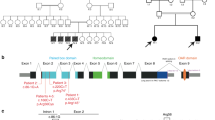Abstract
Expansion of the trinucleotide repeat (CAG)n in the first exon of the androgen receptor gene is associated with a rare motor neuron disorder, X–linked spinal and bulbar muscular atrophy. We have found that expanded (CAG)n alleles undergo alteration in length when transmitted from parent to offspring. Of 45 meioses examined, 12 (27%) demonstrated a change in CAG repeat number. Both expansions and contractions were observed, although their magnitude was small. There was a greater rate of instability in male meiosis than in female meiosis. We also found evidence for a correlation between disease severity and CAG repeat length, but other factors seem to contribute to the phenotypic variability in this disorder.
This is a preview of subscription content, access via your institution
Access options
Subscribe to this journal
Receive 12 print issues and online access
$209.00 per year
only $17.42 per issue
Buy this article
- Purchase on Springer Link
- Instant access to full article PDF
Prices may be subject to local taxes which are calculated during checkout
Similar content being viewed by others
References
Kennedy, W.R., Alter, M. & Sung, J.H. Progressive proximal spinal and bulbar muscular atrophy of late onset: A sex-linked recessive trait. Neurology 18, 671–680 (1968).
Arbizu, T., Santamaria, J., Gomez, J.M., Quilez, A. & Serra, J.P. A family with adult spinal and bulbar muscular atrophy, X-linked inheritance and associated testicular failure. J. neurol. Sci. 59, 371–382 (1983).
Harding, A.E. et al. X-linked recessive bulbospinal neuropathy: a report of ten cases. J. neurol. neurosurg. Psychiatry 45, 1012–1019 (1982).
Fischbeck, K.H. et al. Localization of the gene for X-linked spinal muscular atrophy. Neurology 36, 1595–1598 (1986).
Brown, C.J. et al. Androgen receptor locus on the X chromosome: regional localization to Xq 11-12 and description of a DNA polymorphism. Am. J. hum. Genet. 44, 264–269 (1989).
Fischbeck, K.H., Souders, D. & La Spada, A.R. A candidate gene for X-linked spinal muscular atrophy. Advances in Neurology 56, 209–214 (1991).
La Spada, A.R., Wilson, E.M., Lubahn, D.B., Harding, A.E. & Fischbeck, K.H. Androgen receptor gene mutations in X-linked spinal and bulbar muscular atrophy. Nature 352, 77–79 (1991).
Kremer, E.J. et al. Mapping of DNA instability at the fragile X to a trinucleotide repeat sequence p(CGG)n. Science 252, 1711–1714 (1991).
Verkerk, A.J.M.H. et al. Identification of a gene (FMR-1) containing a CGG repeat coincident with a breakpoint cluster region exhibiting length variation in fragile X syndrome. Cell 65, 905–914 (1992).
Brook, J.D. et al. Molecular basis of myotonic dystrophy: Expansion of a trinucleotide (CTG) repeat at the 3′ end of a transcript encoding a protein kinase family member. Cell 68, 799–808 (1992).
Harley, H.G. et al. Expansion of an unstable DNA region and phenotypic variation in myotonic dystrophy. Nature 355, 545–546 (1992).
Buxton, J. et al. Detection of an unstable fragment of DNA specific to individuals with myotonic dystrophy. Nature 355, 547–548 (1992).
Fu, Y.H. et al. An unstable triplet repeat in a gene related to myotonic muscular dystrophy. Science 255, 1256–1258 (1992).
Fu, Y.H. et al. Variation of the CGG repeat at the fragile X site results in genetic instability: resolution of the Sherman paradox. Cell 67, 1047–1058 (1991).
Mahadevan, M. et al. Myotonic dystrophy mutation: an unstable CTG repeat in the 3′ untranslated region of the gene. Science 255, 1253–1255 (1992).
Edwards, A., Hammond, H.A., Jin, L., Caskey, C.T. & Chakraborty, R. Genetic variation at five trimeric and tetrameric tandem repeat loci in four human population groups. Genomics 12, 241–253 (1992).
Biancalana, V. et al. Moderate instability of the trinucleotide repeat in spino bulbar muscular atrophy. Hum. molec. Genet. 1, 255–258, (1992).
Pieretti, M. et al. Absence of expression of the FMR-1 gene in fragile X syndrome. Cell 66, 817–822 (1991).
Tsilfidis, C., MacKenzie, A.E., Mettler, G., Barcelo, J. & Korneluk, R.G. Correlation between CTG trinucleotide repeat length and frequency of severe congenital myotonic dystrophy. Nature Genet. 1, 192–195 (1992).
Richards, R.I. & Sutherland, G.R. Heritable unstable DNA sequences. Nature Genet. 1, 7–9 (1992).
Caskey, C.T., Pizzuti, A., Fu, Y.H., Fenwick, R.G. & Nelson, D.L. Triplet repeat mutations in human disease. Science 256, 784–789 (1992).
Author information
Authors and Affiliations
Rights and permissions
About this article
Cite this article
La Spada, A., Roling, D., Harding, A. et al. Meiotic stability and genotype – phenotype correlation of the trinucleotide repeat in X–linked spinal and bulbar muscular atrophy. Nat Genet 2, 301–304 (1992). https://doi.org/10.1038/ng1292-301
Received:
Accepted:
Issue Date:
DOI: https://doi.org/10.1038/ng1292-301
This article is cited by
-
The relationship between common mutations in CFTR, AR genes, Y chromosome microdeletions and karyotyping abnormalities with very severe oligozoospermia in Iranian men
Genes & Genomics (2023)
-
Effect of leuprorelin in bulbar function of spinal and bulbar muscular atrophy patients: observational study for 1 year
Journal of Neurology (2021)
-
Unveiling synapse pathology in spinal bulbar muscular atrophy by genome-wide transcriptome analysis of purified motor neurons derived from disease specific iPSCs
Molecular Brain (2020)
-
Gene expression analysis reveals early dysregulation of disease pathways and links Chmp7 to pathogenesis of spinal and bulbar muscular atrophy
Scientific Reports (2019)
-
The clinical application of preimplantation genetic diagnosis for the patient affected by congenital contractural arachnodactyly and spinal and bulbar muscular atrophy
Journal of Assisted Reproduction and Genetics (2016)



